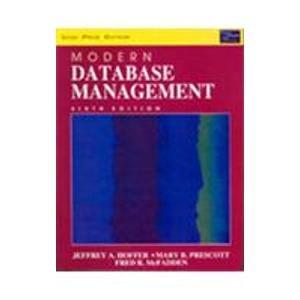Question
Q2. Design an EER schema diagram to keep track of information for an art museum. Discuss any assumptions you make. The application needs to keep
Q2. Design an EER schema diagram to keep track of information for an art museum. Discuss any assumptions you make. The application needs to keep track of the following information:
The museum has a collection of ART_OBJECTS. Each ART_OBJECT has a unique Id_no, an Artist (if known), a Year (when it was created, if known), a Title, and a Description. The art objects are categorized in several ways, as discussed below.
ART_OBJECTS are categorized based on their type. There are three main typesPAINTING, SCULPTURE, and STATUEplus another type called OTHER to accommodate objects that do not fall into one of the three main types.
A PAINTING has a Paint_type (oil, watercolor, etc.), material on which it is Drawn_on (paper, canvas, wood, etc.), and Style (modern, abstract, etc.). A SCULPTURE or a statue has a Material from which it was created (wood, stone, etc.), Height, Weight, and Style. An art object in the OTHER category has a Type (print, photo, etc.) and Style.
ART_OBJECTs are categorized as either PERMANENT_COLLECTION (objects that are owned by the museum) and BORROWED. Information captured about objects in the PERMANENT_COLLECTION includes Date_acquired, Status (on display, on loan, or stored), and Cost. Information captured about BORROWED objects includes the Collection from which it was borrowed, Date_borrowed, and Date_returned.
Information describing the country or culture of Origin (Italian, Egyptian, American, Indian, and so forth) and Epoch (Renaissance, Modern, Ancient, and so forth) is captured for each ART_OBJECT.
The museum keeps track of ARTIST information, if known: Name, DateBorn (if known), Date_died (if not living),

Country_of_origin, Epoch, Main_style, and Description. The Name is assumed to be unique.
Different EXHIBITIONS occur, each having a Name, Start_date, and End_date. EXHIBITIONS are related to all the art objects that were on display during the exhibition.
Exercise 6.2: Determine the horizontal and vertical components of forces that pins A and C exert on the frameStep by Step Solution
There are 3 Steps involved in it
Step: 1

Get Instant Access to Expert-Tailored Solutions
See step-by-step solutions with expert insights and AI powered tools for academic success
Step: 2

Step: 3

Ace Your Homework with AI
Get the answers you need in no time with our AI-driven, step-by-step assistance
Get Started


